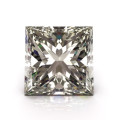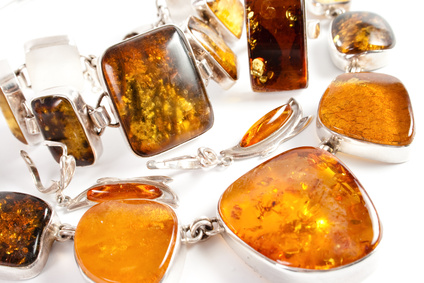What Exactly Are Diamond Inclusions?
Diamond inclusions are simply flaws that developed within the stone at the time it was formed.

Diamond flaws developed when the stone was formed.
Inclusions can take many forms, but the ones visible to the naked eye look like knots, dark spots, clouds, small cracks or lines.
These flaws are usually inside the stone and are of natural origin; they cannot be fixed and are perfectly normal.
Note: External flaws, found on a diamond’s surface, are usually called “blemishes”.
How Do Diamond Inclusions Develop?
Diamonds are crystals that formed deep inside the earth under high pressure and extreme heat.
During this process, another crystal or even a smaller diamond can be captured inside the stone’s structure.
These captive crystals look like small dots, and if there are a lot of them in a certain area of the diamond, they can appear as light or dark clouds within the stone.
When your diamond formed (millions, even billions of years ago), it didn’t do so smoothly, and as a result, irregularities formed within the crystalline structure – these flaws look like lines.
During the formation, cracks may also develop, and sometimes, they are visible to the naked eye. In the process, the diamond may also have captured air within its crystals, and this air will now be seen as bubbles.
What Kinds of Diamond Inclusions Are There?
Diamond inclusions are internal flaws that developed within a diamond at the time of its crystallization, millions of years ago.

The safest diamond clarity grades are in the SI range and higher.
Once formed, inclusions don’t grow or change; they can sometimes be removed through clarity enhancement techniques.
The most commonly seen inclusions are in the form of black spots (carbon that hasn’t crystallized), lines, small crystals (visible as pinpoints or clouds), and cracks.
The bigger, more numerous, and more visible these internal flaws are within a stone, the lower its clarity is graded.
Although inclusions are constant in size and shape, they can make a stone weak and more likely to crack if pressure is applied to it at the time of repair, mounting, or when hit or bumped accidentally.
Which Inclusions Can Weaken Your Diamond?
Whether the inclusions present in a certain diamond will weaken its structure depends on how many of them are there, how big they are, and where they are located.
Let’s take a look at each of these factors:
Number of Inclusions
Each inclusion makes the structure of a diamond less uniform, compromising its integrity.
However, a couple of inclusions here and there won’t make much of a difference. It is when these flaws are too many that the diamond becomes weak. To create real problems, though, the inclusions also need to be big enough.
Size of Inclusions
Your diamond can have lots of tiny inclusions that you may never notice with the naked eye, and many of them may not be visible even with a microscope.
Such imperfections are too small to be problematic, even if they are numerous. It is large inclusions that can seriously affect the integrity of a stone.
Location of Inclusions
Where an inclusion is located plays an important role in how much harm it can do. Flaws that are deep inside a diamond pose less risk than those closer to the stone’s surface.
For example, a small line buried within your diamond is not as dangerous as one that reaches the top of the stone as a hit on its surface can cause it to crack along the inclusion.
In sum, to pose a real threat to your diamond, the inclusions inside it need to be reasonably big. Once these inclusions are large enough (usually, enough to be seen with the naked eye), the more there are and the closer they are to the surface, the weaker the stone will be.
Which Diamond Clarity Grades Are at Risk?
Diamonds whose structural integrity you shouldn’t worry about are those that don’t have a lot of big and visible inclusions.
This means that the safest clarity grades are in the SI range and higher: SI1 is a grade that doesn’t have inclusions big enough to be seen with the naked eye; SI2 stones can have some visible inclusions close to the edge, but they are too small to be cause for concern.
The problematic stones are in the I-clarity range, which contains the I1, I2 and I3 grades. I1 diamonds have inclusions that are easily visible, but for the most part, they are not as numerous or big to cause serious problems.
Stones start to get risky in the I2 grade, and once you get to the I3-clarity diamonds, structural weakness becomes a real problem.
Avoiding Brittle Diamonds When Shopping
I-clarity diamonds are attractive because of their relatively low prices.
However, before you decide to buy such a stone, you should ask yourself whether you are comfortable with the risk of ending up with a cracked or chipped diamond after an accidental hit.
While I1 stones may not be so risky, if you are looking at I2 or I3 diamonds, it is recommended that you think twice about the tradeoff between price and safety.
To avoid any potential problems with inclusions weakening your diamond’s structure, stick with stones of clarity SI2 and higher.
The Types of Diamond Inclusions You Should Avoid
Chips: Visible and Weakening
Chips are surface flaws and they are always annoying as they can be seen easily. The problem with chips is not only visual, though – once the integrity of the stone’s surface has been damaged, the diamond is more likely to chip again in the same place if hit.
You should avoid diamonds with chips around the edge (the girdle) as such flaws can significantly weaken the diamond’s structure.
Needless to say, chips also lower the value of your stone. That’s why when buying a diamond, you should inspect it using a loupe and feel its surface and edge with your finger for irregularities.
Be especially careful if you are buying used jewelry as the diamonds in it are more likely to have chips.
Also, you should always look at the diamonds you are about to buy when they are taken out of their setting, which can conceal some of their defects.
If you have a chipped diamond and you want to get rid of the chip, you can have the stone re-cut by a jeweler.
This means that the cutter will remove some material from all sides of the stone until the chip disappears. Of course, the diamond’s carat weight will go down in the process, and your stone will lose value (and size).
Cracks: More Insidious than Other Inclusions
The cracks or cleavages in a diamond are usually visible as lines inside it.
These inclusions are particularly dangerous because they weaken the stone’s internal structure. As a result, the diamond is more vulnerable to stress, and a stronger blow can cause the stone to split along the cracks.
Usually, diamonds with cracks will have a low clarity grade and will be a lot cheaper than stones of higher quality. However, paying less money for such a stone is hardly worth the risk of ending up with a broken diamond at some point in the future.
In general, avoid diamonds with long cracks inside them, and be especially wary of stones with lines that reach the surface of the stone – such inclusions make the stone more prone to damage.
Black Dots: Just a Visual Defect?
The black dots you can sometimes see in a diamond are simply areas where carbon hasn’t crystallized and has thus remained black.
Take a look at these I1-clarity diamonds — many of them have black spots, and you can see what they actually look like.
If there are too many of them, these spots can stand out and detract from the visual appeal of the stone, especially if they are larger.
Apart from being an optical nuisance, black spots do not present any real danger to the structure of a diamond.
In general, avoid stones with too many and too large black spots because apart from being annoying, they can block the light entering the stone, causing it to lose its sparkle.
To avoid black spots, it is best to select from diamonds of higher clarity and pick a stone that doesn’t have such inclusions. For example, these VS1/VS2-clarity diamonds are much less likely to have black spots than lower-clarity stones.
Our tip: If you are choosing among lower clarity diamonds that all have black spots, pick a stone whose dots are concentrated in places where they will not be visible when you wear it, i.e. on the sides or deep inside the stone. Avoid diamonds with spots closer to the top of the stone.
Can Diamond Inclusions Develop After Purchase?
Diamond inclusions are permanent and they don’t appear suddenly or disappear once they have formed. There is no way a new inclusion can suddenly occur within your stone.
If you notice that there is a black dot or a line within your diamond, and you are convinced that you never saw it before, you are probably wrong.
When dirt particles accumulate on a diamond’s surface over time, they block light and reduce the stone’s sparkle, making internal flaws more visible.
It is true that diamonds can develop cracks, but it takes a pretty strong blow to the stone to do such damage, and it will not look like a small inclusion.
Chips and other flaws can develop on the surface of the diamond, but they would be a result of external stress, and since those flaws are not internal, they are not considered inclusions.
Why Inclusions Can Be Useful
At first, it might seem counterintuitive that flaws could be of any help, but in some cases, this is true.
Diamond inclusions are unique to every single stone and can therefore help identify your diamond among others.
If you buy a certified diamond, its report will most likely contain a diagram of all inclusions within the stone (this is also called a “diamond plot”).
If for any reason you suspect that the stone in your hand is not your original diamond, you can always tell which diamond is yours by its unique inclusions.
How to Make Sure Inclusions Are Not Visible
The best way to ensure no inclusions are visible within your stone is to buy a diamond that has a high clarity grade. Look for diamonds that have no flaws that you can see with the naked eye.
To make your diamond looks as flawless as possible, clean it often. Removing the dirt from your stone ensures that light can pass unobstructed through the diamond, creating brilliance that makes internal flaws less prominent.
What to Do with Low-Clarity Diamonds with Lots of Inclusions
Sometimes low-clarity diamonds look dirty because there are a lot of inclusions in them. This is often the case when the diamond has many carbon spots inside, which look like black dots. There are several ways to conceal that “dirty” effect, although your success may vary depending on the clarity grade of the stone and the position of the inclusions.
Put the diamond in a setting that increases light entry. The more light enters a stone, the higher its brilliance, and as already mentioned, brilliance can help mask diamond imperfections.
In general, prong settings allow the most light to enter the diamond, and fewer prongs (four or six) are preferable if you want maximum brightness.
Full bezel settings and channel settings, on the other hand, hide a greater portion of the stone.
Position the diamond in the setting so as to hide inclusions. This would be most effective if the inclusions are concentrated only in some parts of the stone, and the further from the center, the better.
Ask the jeweler who is setting your diamond to do his or her best to conceal the more visible flaws with the setting’s prongs or bezels, if possible.
Keep the diamond clean. It is important to keep your stones clean because when dirt accumulates, it reduces their brilliance, and their internal flaws and yellow tints (if any) can become more visible because there is less sparkle to hide them. This is why cleaning a low-clarity stone regularly is very important, as keeping its sparkle alive can make inclusions less visible.
This is also why it is a good idea to put such a stone in a setting that makes cleaning easier (e.g., a prong setting).
And last but not least, if you have to buy a “dirty” diamond with lots of small inclusions, it is best if its cut is of top quality. This way, the brilliance of the stone will be maximized, and the visibility of its flaws will be diminished as much as possible.
Where to Buy Diamond Jewelry?
We recommend James Allen (read review) because you can see a 360-degree video for any diamond before buying it.
Blue Nile is another reputable diamond retailer we recommend.














